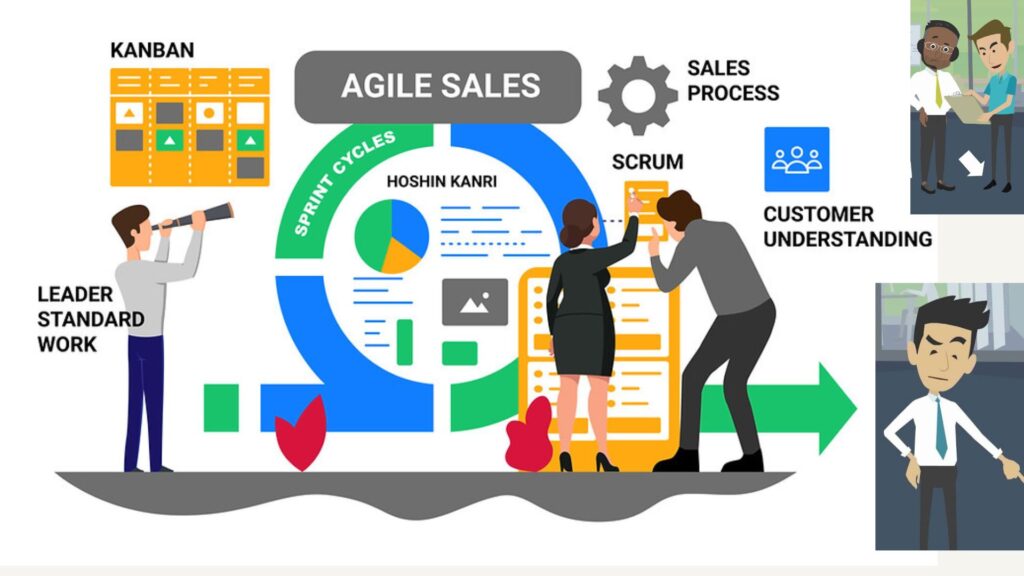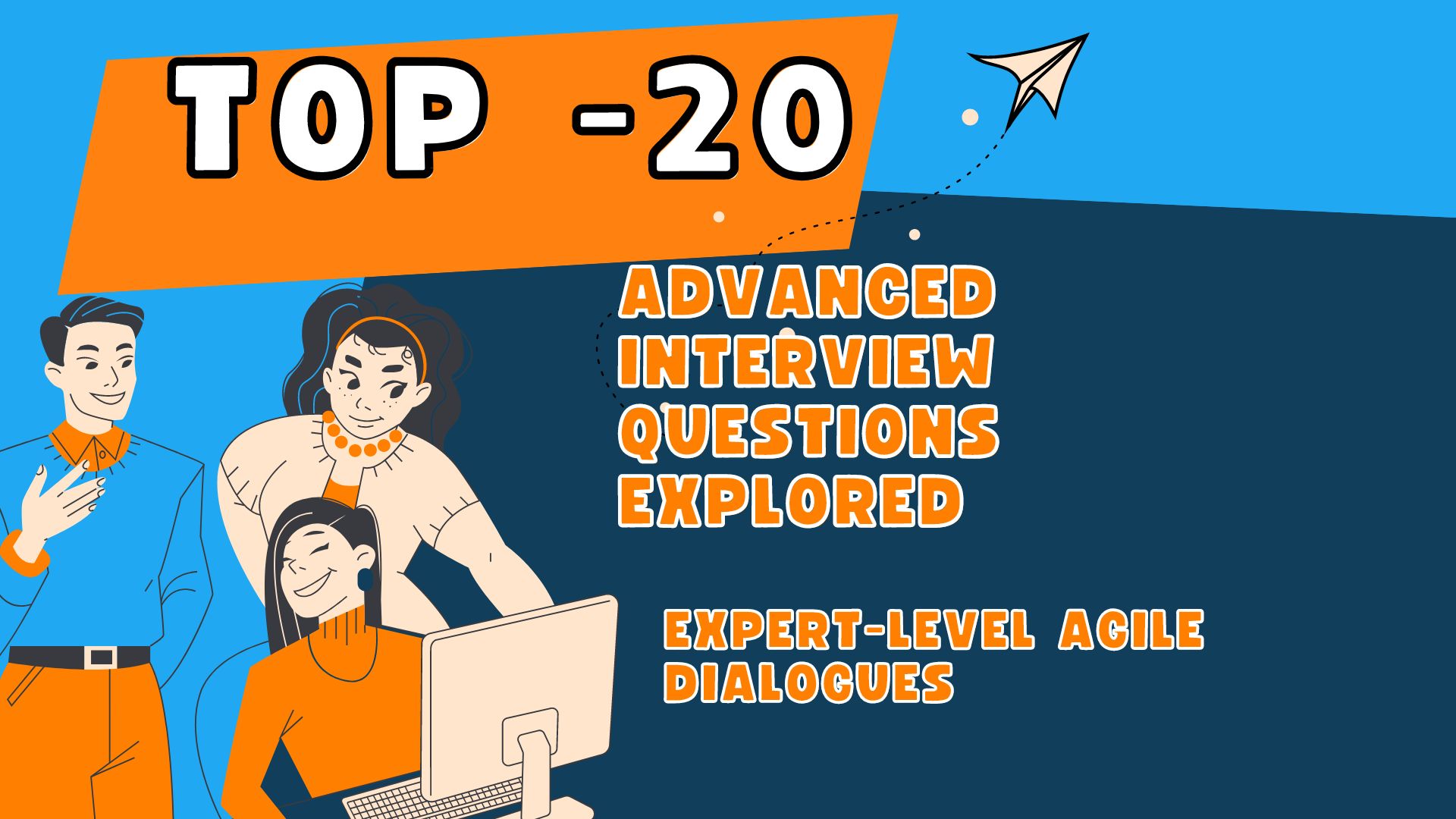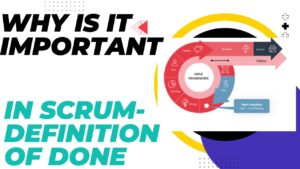Advanced Agile interview questions dive deep into intricate aspects of Agile methodology, assessing your expertise in addressing complex scenarios. These questions explore topics like integrating Agile with DevOps, managing technical debt, scaling Agile with frameworks such as SAFe, and ensuring compliance in regulated industries. They also probe your understanding of Agile’s role in risk management, cross-functional collaboration, innovation, and organizational change. Answering these questions showcases your ability to apply Agile principles effectively, fostering adaptability, creativity, and continuous improvement within dynamic project environments.
Table of Contents
1. How can Agile practices be integrated with DevOps methodologies?
- Answer: Integrating Agile and DevOps involves creating a seamless workflow where development, testing, and operations collaborate. Continuous integration and continuous deployment (CI/CD) pipelines ensure rapid and reliable releases. For instance, consider a software project where Agile practices guide the iterative development of features, while DevOps automates testing, deployment, and monitoring processes. This collaboration accelerates the feedback loop, enabling teams to deliver updates quickly and reliably.
- DevOps integration involves seamless collaboration among development, testing, and operations teams.
- CI/CD pipelines ensure rapid and reliable releases, accelerating feedback loops.
- Example: In a software project, Agile guides iterative feature development, while DevOps automates testing, deployment, and monitoring. This collaboration results in frequent and dependable releases, such as weekly updates to a mobile app.

2. Explain the concept of “Scaled Agile Framework” (SAFe) and its benefits.
- Answer: SAFe is a framework for scaling Agile practices across large enterprises. It offers roles, events, and artifacts to facilitate alignment, collaboration, and delivery at scale. The benefits include improved organizational agility and synchronized delivery across multiple teams. Imagine a global financial organization adopting SAFe to ensure consistent Agile practices among various development teams across different regions. This framework helps align strategies, enhance communication, and deliver cohesive products or services.
- SAFe facilitates scaling Agile across large enterprises, aligning roles and processes.
- Benefits include enhanced organizational agility and synchronized delivery.
- Example: A multinational corporation adopts SAFe to ensure uniform Agile practices. Teams in different regions follow SAFe’s ceremonies, ensuring a synchronized product release across various markets.
3. How do you manage technical debt within Agile projects?
- Answer: Agile teams address technical debt by allocating time in each sprint for refactoring and improvement tasks. For example, consider a software development project where a team dedicates a portion of their sprint to tackle technical debt, such as cleaning up code, improving performance, or resolving legacy issues. This proactive approach maintains code quality and prevents the accumulation of technical debt that could slow down future development.
- Agile teams allocate time for refactoring and improvement tasks within sprints.
- Regular addressing of technical debt maintains code quality and prevents accumulation.
- Example: In a software project, a portion of each sprint is dedicated to resolving technical debt, ensuring ongoing code maintainability and preventing future development bottlenecks.
4. What strategies can prevent Agile ceremonies from becoming routine?
- Answer: To keep Agile ceremonies engaging, teams can rotate facilitators for each ceremony. For instance, in a Scrum team, different members take turns leading daily standup meetings or sprint retrospectives. This approach injects fresh perspectives, encourages active participation, and prevents monotony, as each facilitator brings their unique style and insights to the process.
- Answer:
- Rotating facilitators for ceremonies injects fresh perspectives and maintains engagement.
- Different members lead daily standups or retrospectives, preventing monotony.
- Example: In a Scrum team, rotating the role of Scrum Master for each sprint ensures diverse leadership styles, keeps ceremonies engaging, and encourages active participation.
5. How does Agile accommodate regulatory compliance in industries like healthcare or finance?
- Answer: Agile can address regulatory compliance by integrating regulatory requirements into user stories. For example, in a healthcare software project, a user story could focus on implementing HIPAA-compliant data handling and privacy measures. Frequent compliance reviews and approvals become part of the sprint process, ensuring that the product aligns with industry regulations while remaining flexible to changes in compliance standards.
- Answer:
- Agile integrates regulatory requirements into user stories and conducts regular compliance reviews.
- User stories encompass compliance aspects, and approvals are part of the sprint process.
- Example: In a healthcare software project, a user story could focus on implementing HIPAA-compliant data handling. Compliance checks and approvals are incorporated into sprint activities, ensuring adherence to industry regulations.
6. Describe the “Definition of Ready” and its role in Agile.
- Answer: The “Definition of Ready” outlines the criteria a user story must meet before being included in a sprint. It ensures that tasks are well-defined and that the team has the necessary information to work effectively. For instance, before a user story is considered “ready,” it should have clear acceptance criteria, detailed specifications, and any required assets, such as design mockups or technical documentation.
- Answer:
- The “Definition of Ready” outlines criteria a user story must meet before entering a sprint.
- It ensures well-defined tasks and required information are available.
- Example: A user story is considered “ready” when it has clear acceptance criteria, detailed specifications, and necessary design mockups, ensuring the team’s readiness to work on it.
7. How do you balance short-term customer demands with long-term product vision in Agile?
- Answer: Agile roadmaps help balance short-term demands with the long-term product vision. Imagine a software product where 60% of each sprint is dedicated to addressing immediate customer requests, while the remaining 40% focuses on architectural improvements to support the product’s future scalability. This approach ensures that customer needs are met while also laying the groundwork for the product’s long-term success.
- Answer:
- Agile roadmaps allocate sprint capacity to immediate customer needs and future product vision.
- Short-term customer requests align with long-term architectural improvements.
- Example: A software product dedicates a portion of each sprint to customer-requested features while reserving time for architectural enhancements that support scalability and long-term product goals.
8. What role does the Agile Coach play in a mature Agile organization?
- Answer: In a mature Agile organization, an Agile Coach focuses on enhancing team and organizational practices. They mentor teams, guide continuous improvement initiatives, and identify opportunities for growth. For example, an Agile Coach might introduce innovative retrospectives or facilitate cross-team knowledge-sharing sessions to foster a culture of continuous learning and improvement.
- Answer:
- An Agile Coach mentors teams, guides continuous improvement, and identifies growth opportunities.
- They introduce innovative practices and facilitate knowledge sharing.
- Example: An Agile Coach facilitates cross-team workshops to share successful practices, fosters collaboration, and ensures consistent Agile adoption across the organization.
9. How can Agile principles enhance innovation and creativity within teams?
- Answer: Agile practices encourage innovation through dedicated time for experimentation and learning. Consider a design team that allocates a sprint for creative brainstorming and prototyping. This “Innovation Sprint” fosters a culture of creativity, empowers team members to explore new ideas, and results in innovative solutions that can drive product differentiation and customer value.
- Answer:
- Agile practices provide dedicated time for experimentation and creative brainstorming.
- Innovation sprints or sessions foster a culture of creativity and result in novel solutions.
- Example: A design team allocates a sprint for brainstorming and prototyping innovative ideas, leading to creative design solutions and enhancing user experience.
10. Explain the “Lean Startup” approach and its connection to Agile.
Answer: The Lean Startup approach emphasizes building a Minimum Viable Product (MVP) quickly to validate assumptions and gather feedback from users. This approach aligns with Agile’s iterative delivery model. For example, a startup following the Lean Startup approach might use Agile practices to release an MVP, gather user feedback, and iteratively refine the product based on real-world usage data.
- The Lean Startup approach emphasizes building a Minimum Viable Product (MVP) quickly to gather user feedback.
- It aligns with Agile’s iterative model, enabling iterative development and improvement. –
Example: A startup follows Agile practices to release an MVP, gather user feedback, and iteratively enhance the product based on real-world usage, ensuring that the final product meets user needs.
11. How does Agile address risk management in complex projects?
Answer: Agile addresses risk management through frequent inspections, adaptations, and transparency. Regular retrospectives provide opportunities to identify and mitigate potential risks early in the project. For instance, consider a complex software development project where Agile’s iterative nature allows the team to identify and address architectural risks in the early stages, reducing the likelihood of major disruptions later on.
- Agile employs frequent inspections, adaptations, and transparency to manage risks.
- Regular retrospectives help identify and mitigate potential issues early in the project.
Example: In a complex software development project, Agile’s iterative approach enables the team to detect architectural risks early, leading to adjustments and reduced risks of major disruptions during later stages.
12. What is the role of architecture in Agile development?
Answer: Architecture in Agile evolves incrementally. Initial architectural decisions guide development, and subsequent iterations refine the design based on emerging requirements and insights. In practice, an architecture spike may involve dedicating a sprint to exploring and defining the overall system structure, ensuring that the design accommodates current and future needs.
- Architecture evolves incrementally in Agile, with initial decisions guiding development and subsequent iterations refining the design.
- An architectural spike may involve a dedicated sprint to explore and define the overall system structure.
Example: An Agile team works on a software project, iteratively building components while refining the architectural design based on evolving requirements, ensuring a scalable and adaptable system.
13. How does Agile cater to remote or geographically distributed teams?
Answer: Agile employs virtual collaboration tools and emphasizes clear communication to accommodate remote teams. Video conferencing facilitates daily standups, while online boards help visualize work. For instance, a distributed Agile team may use video conferencing for sprint planning sessions and maintain an electronic board for tracking tasks and progress.
- Agile employs virtual collaboration tools and emphasizes clear communication for remote teams.
- Video conferencing and online boards facilitate daily standups and task tracking.
Example: A distributed Agile team holds daily standup meetings via video conferencing, uses virtual boards to manage tasks, and collaborates seamlessly on tasks and issues across different time zones.
14. How can Agile principles be applied beyond software development, such as in marketing or HR?
Answer: Agile principles can be adapted to various domains, such as marketing or HR. For example, Agile marketing might involve rapid adjustments to campaign strategies based on real-time analytics. In HR, Agile practices can streamline hiring processes, incorporating iterative feedback loops for candidate assessments and enhancing the overall hiring experience.
- Agile principles can be adapted to domains like marketing or HR for iterative improvement.
- In marketing, Agile enables rapid campaign adjustments based on real-time analytics.
Example: An Agile marketing team adapts campaign strategies based on social media engagement metrics, adjusting content and targeting to optimize campaign performance in real-time.
15. Explain the role of experimentation and continuous improvement in Agile.
Answer: Experimentation and continuous improvement are core principles in Agile. Teams use retrospectives to reflect on processes and outcomes, identifying areas for enhancement. For instance, a product team might conduct A/B testing on a website to gather data, analyze user behavior, and make informed design improvements based on the experiment’s results.
- Agile promotes experimentation and learning through continuous improvement practices.
- Teams use retrospectives to reflect on outcomes and implement changes.
Example: A product team conducts A/B testing on a website, analyzing user behavior to iteratively enhance the user experience and improve conversion rates based on data-driven insights.

16. How does Agile support cross-functional collaboration in large organizations?
Answer: Agile frameworks like Scrum of Scrums or SAFe facilitate cross-functional collaboration in large organizations. These frameworks enable regular cross-team meetings and alignment sessions. In a multinational company, a Scrum of Scrums meeting might involve representatives from different regions, ensuring a unified approach and fostering global collaboration.
- Agile frameworks like Scrum of Scrums or SAFe facilitate alignment and coordination across multiple teams.
- Cross-team meetings ensure collaboration and a unified approach.
Example: A large organization adopts Scrum of Scrums, where representatives from various teams participate in regular meetings to synchronize efforts, address dependencies, and ensure cohesive progress across different departments.
17. What strategies can ensure effective knowledge sharing within Agile teams?
Answer: Agile teams promote knowledge sharing through practices like pair programming, code reviews, and knowledge-sharing sessions. For example, a software development team might conduct regular “tech talks,” where team members share insights, discuss best practices, and showcase innovative solutions, fostering a culture of continuous learning and collaboration.
- Agile teams promote knowledge sharing through practices like pair programming and code reviews.
- Regular “tech talks” or knowledge-sharing sessions enhance learning and collaboration.
Example: Developers participate in pair programming sessions, where team members share insights, exchange coding techniques, and learn from each other’s expertise to collectively improve coding practices.
18. How does Agile address stakeholder engagement and communication in complex projects?
Answer: Agile maintains regular stakeholder engagement through events like Sprint Reviews and clear communication channels. These practices provide opportunities for stakeholders to provide feedback and stay informed about project progress. In a complex construction project, for instance, stakeholders could attend sprint reviews to witness completed phases and ensure alignment with project objectives.
- Agile ensures stakeholder engagement through Sprint Reviews and transparent communication.
- Stakeholders provide feedback and stay informed about project progress.
Example: In a complex construction project, stakeholders attend Sprint Reviews, offering insights and ensuring alignment with project objectives while staying updated on completed phases and upcoming work.
19. What is “Feature-Driven Development” (FDD) and its relationship with Agile?
Answer: FDD is an Agile approach that focuses on building features incrementally. It aligns with Agile’s iterative nature by delivering functional increments of a product. In practice, a software development team practicing FDD might release core features first, followed by additional enhancements and functionalities in subsequent iterations.
- FDD is an Agile approach focusing on building features incrementally.
- It aligns with Agile’s iterative delivery by delivering functional increments.
Example: In a software development project, FDD involves releasing core features first and gradually adding enhancements, ensuring that the product evolves based on user needs and feedback.
20. How can Agile principles contribute to organizational change management?
Answer: Agile’s adaptive nature makes it well-suited for organizational change management. Regular retrospectives and feedback loops encourage open discussions about change, enabling teams to embrace and adapt to new ways of working. In a corporate restructuring scenario, Agile practices facilitate smoother transitions by involving teams in defining new roles, responsibilities, and processes.
- Agile’s adaptive nature supports organizational change management.
- Regular retrospectives encourage open discussions about change, while iterative practices ease transitions.
Example: During a corporate restructuring, Agile practices facilitate smoother adoption of new roles and responsibilities. Regular retrospectives allow teams to provide feedback, adapt to new workflows, and embrace the changing organizational landscape.
These advanced-level Agile interview questions and answers offer detailed explanations and real-world examples, showcasing your profound understanding of Agile concepts and your ability to apply them effectively in complex scenarios.



